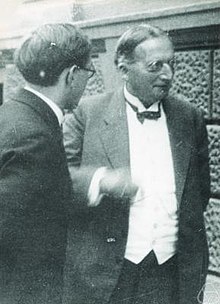Adolf Kneser

Adolf Kneser (born March 19, 1862 in Grüssow , Mecklenburg ; † January 24, 1930 in Breslau ) was a German mathematician who devoted himself to algebraic geometry and analysis .
life and work
Kneser was the son of the pastor and Praepositus in Grüssow, Adolf Hermann Kneser († 1863), and his wife Friedrike Wilhelmine Philippine Auguste, geb. Kollmann, a sister of Albert Kollmann After losing his father at an early age, he grew up in Rostock . His godfather was the physicist Johann Christian Poggendorff . Then he went to the University of Rostock at Easter 1879 , where he published his first work on acoustics . At the Friedrich-Wilhelms-Universität Berlin he heard Leopold Kronecker and Karl Weierstrass . Out at the Ruprecht-Karls-University of Heidelberg , received his doctorate he 1884 in Berlin with a doctoral thesis at Ernst Kummer and Kronecker to Dr. phil.
He completed his habilitation at the Philipps University of Marburg . After a stopover in Breslau, he joined the then Russian University of Dorpat in 1889 as associate professor , which appointed him full professor for applied mathematics the following year . In 1900 he moved to the Bergakademie Berlin and in 1905 to the Schlesische Friedrich-Wilhelms-Universität in Breslau . For the academic year 1911/12 he was elected its rector . He stayed in Breslau until his retirement . Since 1923 he was a corresponding member of the Prussian Academy of Sciences and since 1924 of the Russian Academy of Sciences .
Kneser initially dealt with algebraic functions, elliptic functions and space curves. Later he worked on the Sturm-Liouville problem in the theory of linear ordinary differential equations, integral equations and calculus of variations (theory of the second variation, solution of Mayer's problem). His textbook on the calculus of variations appeared in 1900 and his The Integral Equations and their Applications in Mathematical Physics in 1911, in which he also presented the theory just developed by David Hilbert .
Kneser was also interested in philosophy and the history of science. He published Hobbes und die Staatsphilosophie in 1924 and The Principle of the Smallest Effect from Leibniz to the Present in 1928 .
Kneser had been married to Laura Booth since 1894 and had four sons. His son Hellmuth Kneser and his son Martin Kneser were also well-known mathematicians.
His correspondence with Vladimir Steklow was published by Nauka in Moscow in 1980.
In 1929 he was President of the German Mathematicians Association .
Web links
- Literature by and about Adolf Kneser in the catalog of the German National Library
- Biography in the commemorative publication 125 years of the Technical University of Berlin
- John J. O'Connor, Edmund F. Robertson : Adolf Kneser. In: MacTutor History of Mathematics archive .
- Adolf Kneser in the Mathematics Genealogy Project
Individual evidence
- ↑ Kösener Corpslisten 1930, 122 , 113; Friedrich Walter: Our regional clergy from 1810 to 1888. Biographical sketches of all Mecklenburg-Schwerin clergy. Self-published, Penzlin 1889, p. 102 .
- ↑ Entry in the Rostock matriculation portal .
- ↑ Dissertation: Irreductibility and the monodromic group of algebraic equations. Berlin 1884, ( digitized ).
- ↑ Rector's speeches (HKM)
- ↑ Владимир А. Стеклов, Адольф Кнезер: Научная переписка (1901–1925). Наука, Москва 1980.
| personal data | |
|---|---|
| SURNAME | Kneser, Adolf |
| BRIEF DESCRIPTION | German mathematician |
| DATE OF BIRTH | March 19, 1862 |
| PLACE OF BIRTH | Grüssow , Mecklenburg |
| DATE OF DEATH | January 24, 1930 |
| Place of death | Wroclaw |